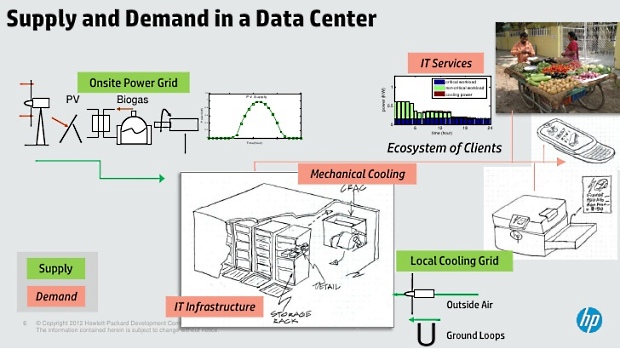HP goes off-grid with datacentre for chaotic regions

HP has designed a datacentre for places where the electricity supply is unreliable, which could ultimately help boost IT operations in countries with poor power grids.

HP's datacentre is designed to get as much of its power and cooling as possible from off-grid, on-site sources, such as renewable energy or local wind-funnelling architecture. Image credit: HP
The design cuts electricity usage by 30 percent and reduces
the dependence on power from a utility grid by more than 80 percent, HP said on Wednesday. It gave details of the technology ahead of a demonstration at its HP Discover conference in Las Vegas next week.
"The HP Net-Zero Energy Data Center not only aims to minimise the environmental impact of computing, but also has a goal of reducing energy costs associated with datacentre operations to extend the reach of IT accessibility globally," Cullen Bash, interim director of sustainable ecosystems research at HP Labs, said in a statement.
The datacentre brings in energy and cooling from renewable sources, like wind and solar power, to make the IT equipment inside less dependent on grid power. The equipment lives in an efficient HP EcoPOD datacentre, going by the schematics published by HP.
Unreliable power
Various software packages provision power and cooling according to demand from the IT equipment. They also ensure that workloads are scheduled at times when renewable energy is expected to be plentiful.
Countries rich in natural resources tend to have unreliable power provisioning — for example, sub-Saharan Africa, mountainous regions in South America and remote parts of Asia. As a consequence, having a datacentre design that is relatively self-contained could take pressure off otherwise expensive supply chains for funnelling fuel to the site for the datacentre's backup generators.
A test facility located at an HP site Palo Alto, California uses a peak of around 120KW to run a range of critical and non-critical workloads, the company said. However, as most datacentres accommodate multiple megawatts of power, the small scale of the test set-up means it cannot be regarded as a real-world facility.
Furthermore, the datacentre is not likely to be suited to workloads that require guaranteed uptime, such as those supporting a major website or cloud service. However, the architecture would be good for batch processing.
"Non-critical, delay-tolerant workloads could be scheduled during daylight hours to coincide with solar supply for datacentres equipped with photovoltaic energy generation," HP said. "In this way, demand can be 'shaped' according to resource availability, to reduce reliance on non-renewable resources."
Datacentre executives in the oil and gas sectors have told ZDNet UK in the past that a semi off-grid facility designed for batch processing would suit many of their workloads.
HP upheaval
The news from HP Labs comes as the company is shaking up its strategy, having seen a tough third quarter and a change in chief executive at the end of last year. Earlier in May, chief executive Meg Whitman pledged to increase HP's investment in research and development to generate new products and services. However, last Thursday, the company announced a "restructuring" that will mean eight percent of the company's workforce — 27,000 people — will be laid off.
More organisational changes followed on Wednesday, with the announcement that Bill Veghte, newly appointed head of HP's software business, has been promoted to chief operating officer. George Kadifa, a former executive in the Silver Lake investment firm, will take over Veghte's role and report directly to Whitman.
Meanwhile, HP created a new position for Jan Zadak, former head of global sales for HP and now president of the Europe, Middle East and Africa region for HP Enterprise Services.
Get the latest technology news and analysis, blogs and reviews delivered directly to your inbox with ZDNet UK's newsletters.